Search for drivers by ID or device name
Known devices: 165022367
Latest known driver: 23.12.2020
The Aerocool XPredator II Case Overview
 The Aerocool XPredator II is an updated and refreshed version of the first XPredator case, which was released six years ago. The modification took into account the realities of modern components, although in the second iteration of the chassis there is still a touch of «muscularity» characteristic of those times when the motherboards of the XL-ATX format, video cards over 300 mm long or 1.5-kilogram processor cooling systems were common.
The Aerocool XPredator II is an updated and refreshed version of the first XPredator case, which was released six years ago. The modification took into account the realities of modern components, although in the second iteration of the chassis there is still a touch of «muscularity» characteristic of those times when the motherboards of the XL-ATX format, video cards over 300 mm long or 1.5-kilogram processor cooling systems were common. Currently, the requirements for case components characteristics are much more modest. But the excess capacity and power of the XPredator II cooling system are superfluous not for everyone, as a number of users actually need to build up a really large and hot system by the nature of their activities or hobbies.
Features
Case type: Full-Tower
Dimensions, mm: 595 (H) x 232 (W) x 570 (D)
Material: ABS plastic, steel (0.8-1 mm)
Weight, kg: 12,5
Color: black
Form factor: E-ATX, XL-ATX, ATX, MicroATX, Mini-ITX
Devices 5.25": 3
3.5" external devices: –
3.5"/2.5" internal devices: 8/8 (2.5" are put in place of 3.5")
Supported number of expansion slots: 10
Front fans: 2 x 120/140 mm (2x140 mm installed)
Upper fans: 2 x 120/140 mm (2x140 mm installed)
Rear fans: 1 x 120/140mm (1x140mm installed)
Bottom fans: 1 x 120/140 mm (optional)
Interface sockets: 4 x USB 2.0, 2 x USB 3.0, microphone in and headphone out, SATA docking station for 2.5"/3.5" drives.
Other: side window, front propellers with red illumination, two two-channel three-position fan speed controllers (5, 7, 12V), removable hard drive basket, ventilation air curtains on top panel.
Packing and Equipment
The case packing is devoid of color printing, but it has a sufficient level of informativeness, all important parameters of the product are indicated here. Protection from internal transportation damage is provided by two dampers made of foamed polyurethane, a plastic bag and transparent stickers on both sides on the side acrylic window. The weight of the box together with the contents is up to 15 kg.
 A set of mounting parts is contained in a neat black box, packaged in individual bags, which greatly simplifies the process of selecting the necessary parts. The kit includes the following:
A set of mounting parts is contained in a neat black box, packaged in individual bags, which greatly simplifies the process of selecting the necessary parts. The kit includes the following:- • visual instructions for assembling the system;
- • 6 cable ties;
- • 13 brass racks of the motherboard;
- • metal adapter for a screwdriver for mounting racks;
- • 4 screws for fixing the fan;
- • 4 small screws for fixing the optical drive;
- • 5 case screws with a hexagonal hat (suitable for fastening the PSU);
- • 13 screws for fixing the motherboard;
- • 32 small screws for mounting 2.5" and 3.5" drives.
Outlook
 The Aerocool XPredator II outlook has undergone minor changes in the design and, on the whole, has retained a family resemblance to its predecessor. Most of the front panel is occupied by a metal ventilation grid, at the bottom of which the silver logo of the company is glued. The number of 5.25" compartments has been reduced to three, each of which is covered with an individual easy-detachable plug.
The Aerocool XPredator II outlook has undergone minor changes in the design and, on the whole, has retained a family resemblance to its predecessor. Most of the front panel is occupied by a metal ventilation grid, at the bottom of which the silver logo of the company is glued. The number of 5.25" compartments has been reduced to three, each of which is covered with an individual easy-detachable plug.Each plug is equipped with its own latch. It can be easily removed from the outside without dismantling or even opening the case. Provided that no 5.25" devices are installed, an experienced user will be able even to replace the RAM in the system just by removing all these plugs.
All external ports and controllers are assembled on the front part of the top panel. The elongated switch-on button and the system power indicator are located on the left side; similarly looking reset button and the drive activity indicator are on the right side of the panel. At the top there is a SATA-pocket for hot-swap of 2.5" and 3.5" drives.
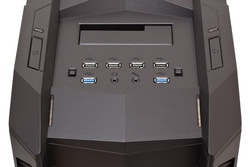
Just below, four USB 2.0 ports are placed, two USB 3.0 ports are located under them, two 3.5-mm audio ports for the microphone and headphones are placed between the USB 3.0 ports. On the sides of the USB sockets there are two inconspicuous sliders of the fan speed controllers. Every switch has three positions (5, 7 and 12V), two propellers can be attached to each of them.
Most of the left side panel is a transparent acrylic window, flushed with the plane of the door. There are no more seats for fans here.
The door itself is made of fairly thick metal, but, even so, and for the presence of stiffeners, it slightly arches diagonally. The window rests on ordinary metal petals. The left panel has a guillotine type of opening (strictly to the side), it has no handle and is supported by two knurled screws.
The right panel is flat and solid, in shape and size completely analogous to the left one. It holds on two knurled screws, there is no handle for easy dismantling.
 On the upper plastic panel of the case, the XPredator’s proprietary feature is preserved – the lifting vent shields. The slider for opening them is located in the middle of the top panel.
On the upper plastic panel of the case, the XPredator’s proprietary feature is preserved – the lifting vent shields. The slider for opening them is located in the middle of the top panel.At the chassis rear panel there is much interesting: at the top there are four rubberized holes for water cooling hoses placed in a row. The space behind the motherboard pallet has its own ventilation slots along the entire height. On the top of the grid one 120- or 140-mm exhaust propeller can be fixed. And the expansion slots here are as many as ten pieces and all of them are covered with reusable vented plugs. To the right of the slots there are honeycomb grids all over the case height.
The power supply can be oriented both with the fan up and down. From the bottom it is shielded from dust by a high-quality easy-detachable filter.
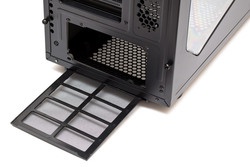 At the bottom of the case there is another ventilation grid where one 120- or 140-mm propeller can be fixed. However, it is not closed by any filter and this is not very good. After all, in the previous version of the case there was a filter here.
At the bottom of the case there is another ventilation grid where one 120- or 140-mm propeller can be fixed. However, it is not closed by any filter and this is not very good. After all, in the previous version of the case there was a filter here.Plastic legs with soft dampers lift the case to a height of 23 mm.
Internal Organization
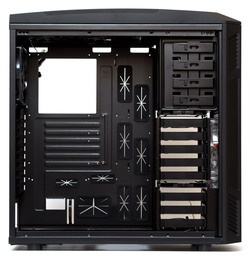 The Aerocool XPredator II supports vertical installation of E-ATX, XL-ATX, ATX, MicroATX and Mini-ITX motherboards. The permissible height of the processor cooler declared by the manufacturer is 170 mm, but in fact even a 190-mm one will fit here. The length of the expansion cards in all slots reaches 340 mm, and after dismantling the hard drive basket, cards up to 460 mm inclusively can be placed into slots from the second through the eighth. The length of the power supply is limited only by the possibility of installing a fan at the bottom of the case. If a 140-mm propeller is planed to be installed here, then the PS should be no longer than 200 mm.
The Aerocool XPredator II supports vertical installation of E-ATX, XL-ATX, ATX, MicroATX and Mini-ITX motherboards. The permissible height of the processor cooler declared by the manufacturer is 170 mm, but in fact even a 190-mm one will fit here. The length of the expansion cards in all slots reaches 340 mm, and after dismantling the hard drive basket, cards up to 460 mm inclusively can be placed into slots from the second through the eighth. The length of the power supply is limited only by the possibility of installing a fan at the bottom of the case. If a 140-mm propeller is planed to be installed here, then the PS should be no longer than 200 mm.Under the top panel two 140-mm fans are pre-installed for blow-out. The space to the edge of the motherboard here is 50 mm. At first glance, this may seem insufficient for the installation of liquid cooling system radiators, but in fact, there are seats for radiators displaced closer to the left panel, which allows them not to touch the plane of the motherboard elements.
The 140 mm fan installed on the top proved to be extremely successful. It claims the use of a conventional bushing as a bearing, but it is so well lubricated and balanced that the impeller remains low-noise even at the maximum 1200 rpm (which corresponds to only 40 dB (A) – noise that is successfully suppressed by a closed housing). The propeller starts at 4 V and 500 rpm, at 5 V it will show 650 rpm, and at 7 V – 900 rpm, remaining silent in all the specified range. To connect to the power supply, one of two connectors can be used here – a three-pin or a through-through Molex (they cannot be turned simultaneously). The length of the cord to the first is 390 mm, and to the second – 50 mm more.

At the rear panel, a 140-mm fan of black color is pre-installed; it is completely analogous to the two top propellers. The plugs of ten PCI expansion slots are held by thumb screws.
Vibration dampers are provided for the power supply on the back and bottom walls.
The seat for a 120- or 140-mm fan is located exactly in the middle of the case bottom. An installed here propeller can improve the airflow to video adapters, but it will rapidly fill the case with dust as there is no filter provided.
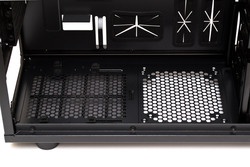
The drives rack consists of two parts: the lower stationary basket for three drives and the upper removable one, which is fixed by two knurled screws and is capable of receiving five more drives.
The basket is removed towards the left door. Slides are plastic and have no rubber gaskets to suppress noise and vibrations. 3.5" hard drives are simply put on these slides (they can be additionally screwed), and 2.5" drives are screwed in the middle. The slides themselves sit in the baskets loosely which can create additional noise if the hard drives vibrate too much.
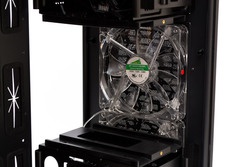 In front two transparent 140 mm propellers with red illumination are pre-installed for air intake. These models start with 5 V and 600 rpm, but even at such minimum speeds they produce a loud enough roar that increases with the speed of the impeller. At 7 V we get 800 rpm and 42 dB (A) noise, and at the maximum 1200 rpm as much as 52 dB (A) which sounds quite unpleasant since the rumble is supplemented by the blades buzzing.
In front two transparent 140 mm propellers with red illumination are pre-installed for air intake. These models start with 5 V and 600 rpm, but even at such minimum speeds they produce a loud enough roar that increases with the speed of the impeller. At 7 V we get 800 rpm and 42 dB (A) noise, and at the maximum 1200 rpm as much as 52 dB (A) which sounds quite unpleasant since the rumble is supplemented by the blades buzzing.The bearing here is also an ordinary sliding sleeve. The power cord is equipped with both a three-pin connector and a through Molex. The length of the cable to the first socket is 480 mm, and another 50 mm are needed to reach the second one.
In the front top part of the case there are four 5.25" compartments, although only three of them have the external output. Nevertheless, all of them have fast locks on both sides. In the open position, the slider on them is shifted back, and in the closed position – forward. Each lock is held on two screws in the middle and can be easily dismantled if necessary.
There is enough space behind the motherboard pallet. The minimum distance margin from the pallet to the side door is 25 mm in the narrowest place, so the cables here can be stacked even overlapping each other. There is a large cutout for the amplification plate of the CPU cooler. There are lots of rubberized holes for pulling wires, but the lugs for cable ties are not enough – there are only three of them.
The front panel is easy to remove; it needs just to be to pulled. There are no wires connected to it, as well as no filters.
Fans on the front panel are covered with a good removable dust filter. However, to remove it one needs to unscrew the four screws which makes cleaning it not the most convenient task.
 Two 140-mm fans are screwed to the frame of the filter and are removed together with it. If desired, they can be replaced by two 120 mm propellers.
Two 140-mm fans are screwed to the frame of the filter and are removed together with it. If desired, they can be replaced by two 120 mm propellers.The top panel also detaches easily if you pull it upwards for the rear recess. But a large pile of wires is attached to it and all of them must be released before dismantling.
The ventilation grid of the top panel has two sets of mounting holes for two 120- or 140-mm fans. The fans can be mounted either closer to the right panel or to the left one, if the installation of the radiator is required (so that it does not touch the motherboard). There are 154x154 mm seating holes here, which are suitable for 200-mm fans.
The set of wires includes standard cables for the power button and the system reboot, as well as for power and drive activity indicators, HD Audio shoe, two USB 2.0 pads and a USB 3.0 socket.


The second wires set consists of a Molex for SATA-pocket, a signal SATA cable for it, four three-pin sockets for connecting fans and two Molexes to power the fan regulators.
Assembly
The assembly of the system into the Aerocool XPredator II is very easy due to the huge space inside. All wires are spontaneously distributed behind the pallet and it is not necessary to work hard laying them.

All the main components are perfectly visible through the completely transparent side window.
There are two stripes of illumination of red color near the panel of external interfaces. They do not glow brightly and do not hit the eyes. The blue power indicator of the system and the red one of the drives activity are also completely comfortable to look at.
The red illumination from the fans is almost indistinguishable in daylight. It can be seen relatively well only in complete darkness.
Conclusions
The updated version of the Aerocool XPredator II case has turned out to be ambiguous in comparison with its predecessor due to a lot of small changes, both positive and negative. The most noticeable moment is an increase in the overall strength of the chassis frame. The ventilation system has been redesigned towards the use of more standard 140-mm fans and the dust protection is improved. The system of expansion cards mounting has become simpler, and the drives and drives baskets have changed their configuration to more closely match the parameters of modern systems.

There are still some drawbacks: in the appeared SATA-pocket there is no protective curtain for the 2,5" compartment. The number of fans supported by the regulators decreased from six to four. The central dust filter disappeared from case bottom. The front fans with the backlight are too noisy. And hard drives baskets have lost their vibration dampers and are fixed not very reliably.
Nevertheless, the most important parameters of the case, namely high capacity and compatibility with any components, as well as excellent ventilation remained unchanged. Aerocool XPredator II is ideal for assembling the largest and hottest systems while leaving its owner full freedom to choose components without any limits.
Comments 0
Collapse comments / Expand comments